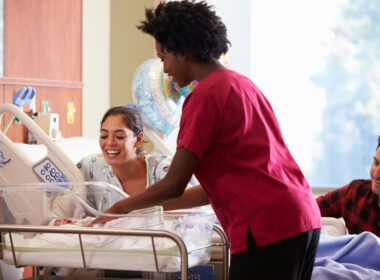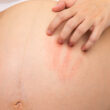By the end of the third trimester, most women are more than ready to have their very, very close-quarters roommate on the outside. Pregnant mamas may wonder: just how much walking does it take to induce labor? Castor oil, spicy foods, and sex are relatively well-known labor-launching options, but might not appeal to everyone and can have unpleasant downsides (if even a glass of water gives you heartburn, I strongly advise against jalapeno poppers). Going on a walk, however, might be worth a try. Even if it doesn’t start labor for you, walking has great benefits during pregnancy and can help provide some relief in early labor. Here, I’ll cover whether walking too much can cause early labor, whether walking at 37 weeks or 39 weeks (or any time once you’re full term) can induce labor, and how to do curb walking.
Can you walk your way to an earlier delivery?
Walking to induce labor may help your baby shift down into a lower position in your pelvis and exert pressure on your cervix. This could help prompt the biochemical cascade of signals to get labor started. However, like most “home remedies” for starting labor, there is little clinical evidence to suggest that walking induces labor. Personal testimonies will argue both for and against. I went into labor at 38 weeks pregnant with my first baby after a busy day with lots of walking. But I have friends who described practically jogging around their local park after their due date came and went, to no avail.
Can walking cause labor at full term?
Will walking at 37 weeks (early term) induce labor? What about walking at 39 weeks (full term), or even 41 weeks (post term)? While this may not be comforting to women who are more than ready to meet their baby on the outside (and to finally be able to take a deep breath again), there’s no guarantee that walking at 39 weeks or any other time will start labor. The good news? According to research, walking at least 40 minutes a day for four days a week throughout the third trimester can decrease the likelihood of having an induction, Cesarean section, or instrument-assisted delivery (using vacuum or forceps) and improve your Bishop score at the start of labor [1].
A 2011 literature review on bed rest in pregnancy found that being physically active reduces the risk of preterm birth, improves cardiovascular health (including better growth of the placenta), and decreases inflammation [2]. On the other hand, bed rest, with its lack of physical activity, has many negative effects on the mom’s body.
And a 2009 study on the effect of walking and stretching exercises for preventing preeclampsia found that while both activities decrease preeclampsia risk, the group assigned to stretching was better able to stick with their exercise program and thus has better outcomes [3]. Whatever form of exercise you enjoy, go with that (even if it doesn’t jump start labor the way you might hope)!
What is curb walking and how might it help get labor started?
Curb walking is just what it sounds like: you go for a walk on the curb, specifically with one foot on the sidewalk and one foot on the gutter/street. If your belly is already making you question your ability to balance well, it might be helpful to bring a buddy and hold hands for safety. The general idea behind curb walking is that if walking just on a flat surface can help baby with setting into his or her birthing position and encourage spontaneous labor, then walking with even more pelvic motion, including a more open stance and uneven gait, can settle baby down in the pelvis more effectively.
But does it work? Like any other induction technique, including medical induction, there is no guarantee that curb walking will start labor. As long as there is no danger of you falling into traffic, there’s no harm in trying it. Does curb walking sound like more trouble than it’s worth? Take a walk with both feet firmly on level ground to enjoy all the benefits of exercise in late pregnancy.
How does walking during labor help?
So, when labor finally starts, how can walking help? Again, the answer is a little mixed. According to 1998 study with around one thousand women on walking in early labor, there was no difference between patients who walked and those who labored in bed in regards to length of labor. The same held true for need for Pitocin, need for pain medication, instrument-assisted birth or C-section rate. The study authors concluded that it is up to the individual’s personal preference on whether or not to walk around during early labor [4].
Is it better to lie down than walk?
The Bradley Method argues that the chief concern of a woman in early labor is relaxation. It suggests a side-lying position with pillows supporting the upper arm and leg as the optimal laboring position, in addition to a dark and quiet environment [5]. This position helps to conserve energy and focus on relaxing through contractions as they come. Of course, early labor can take a long time and may not be intense, especially for first time moms. Some women may find it impractical to spend early labor in bed and may prefer to wait to lie down until labor is more intense.
Lamaze on the other hand, advocates for walking in early labor as a way to keep contractions going and starting to come closer together.
In this editorial published in the Journal of Perinatal Education, the author highlighted evidence that walking can do multiple amazing things. It leads to shorter labors, lower intervention rates, and less severe pain. Plus, it’s associated with more satisfaction with the overall birthing experience [6].
At a minimum, walking certainly doesn’t hurt and it could help. Laboring women should choose the positions and activity level they find most comfortable and move as often as needed.
Are there situations where you may need to avoid walking in early labor?
Bed rest used to be prescribed for a variety of pregnancy conditions. It’s still often recommended for conditions such as premature rupture of membranes (water breaking before the onset of labor), concerns over preterm birth, incompetent cervix, carrying multiples, or vaginal bleeding. However, bed rest during pregnancy is not evidence based. This 2011 literature review on bed rest in pregnancy states bluntly: “There is no evidence to support the use of activity restriction during pregnancy at home or in hospital, and practitioners should not assume efficacy for bed-rest treatment until evidence is produced” [2]. This view is supported by the American College of Obstetricians and Gynecologists (ACOG).
If a woman has high blood pressure in pregnancy, including preeclampsia, it is important to carefully monitor vital signs and symptoms to avoid overexertion. Even without concerns like high blood pressure, it is important not to walk to exhaustion. Birth is a marathon, not a sprint. Taking time to rest during early labor is important for maintaining strength for active labor and the second stage (i.e., the pushing stage) of labor.
Where the rubber meets the road: the bottom line on walking during early labor
How much walking does it take to induce labor? That all depends. While walking may or may not start labor towards the end of pregnancy, it can decrease the likelihood of certain complications. Walking also helps the body prepare for labor. Many women find that movement of any kind in early labor increases contractions and can be a source of relief and distraction. There are also factors like time of day (for everyone who starts labor right when they lay down to go to bed, I feel for you!) and whether or not walking increases your personal level of discomfort during early labor. So, walk your way to a healthy start of labor and then listen to your body. Happy birthing!
References:
[1] Shojaei B, Loripoor M, Sheikhfathollahi M, Aminzadeh F. The effect of walking during late pregnancy on the outcomes of labor and delivery: A randomized clinical trial. J Educ Health Promot. 2021 Jul 30;10:277. doi: 10.4103/jehp.jehp_1437_20. PMID: 34485574; PMCID: PMC8395880. [2] Maloni JA. Lack of evidence for prescription of antepartum bed rest. Expert Rev Obstet Gynecol. 2011 Jul 1;6(4):385-393. doi: 10.1586/eog.11.28. PMID: 22140399; PMCID: PMC3226811. [3] Yeo S. Adherence to walking or stretching, and risk of preeclampsia in sedentary pregnant women. Res Nurs Health. 2009 Aug;32(4):379-90. doi: 10.1002/nur.20328. PMID: 19415672; PMCID: PMC2895148. [4] Kirchner, J. “Effects of walking during the first stage of labor.” Am Fam Physician. vol. 58 no. 9 (1998): pp. 2155-56 [5] McCutcheon, S. (2018). Natural Childbirth the Bradley Way. Plume. [6] Ondeck M. Healthy birth practice #2: walk, move around, and change positions throughout labor. J Perinat Educ. 2014 Fall;23(4):188-93. doi: 10.1891/1058-1243.23.4.188. PMID: 25411538; PMCID: PMC4235058.Additional Reading:
Cervical checks during labor—are they necessary?
Beyond the epidural: labor pain management options
So you’re going to give birth in the United States…what are your options?







